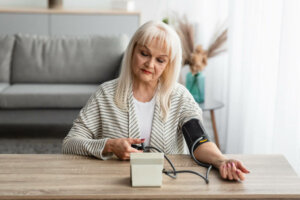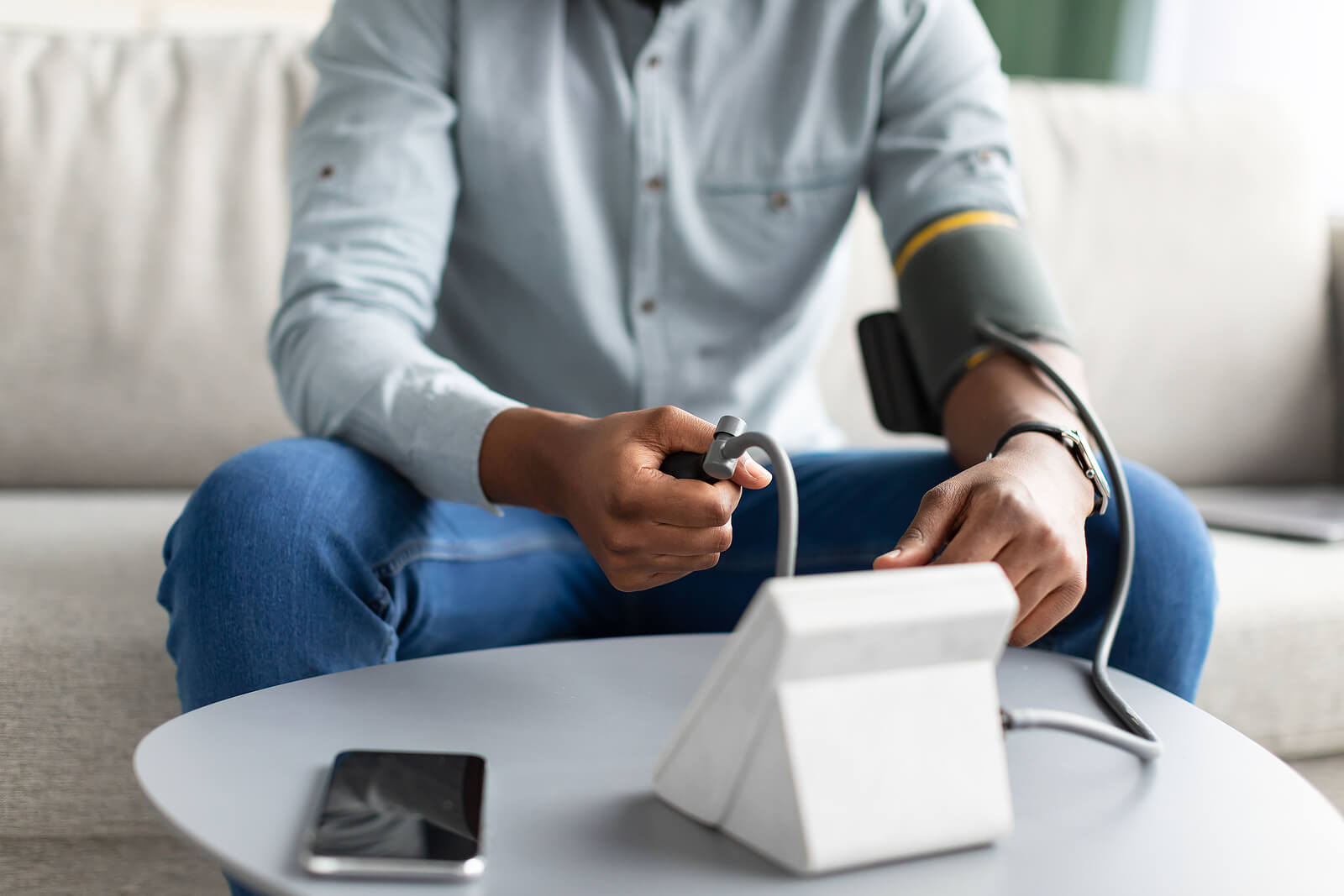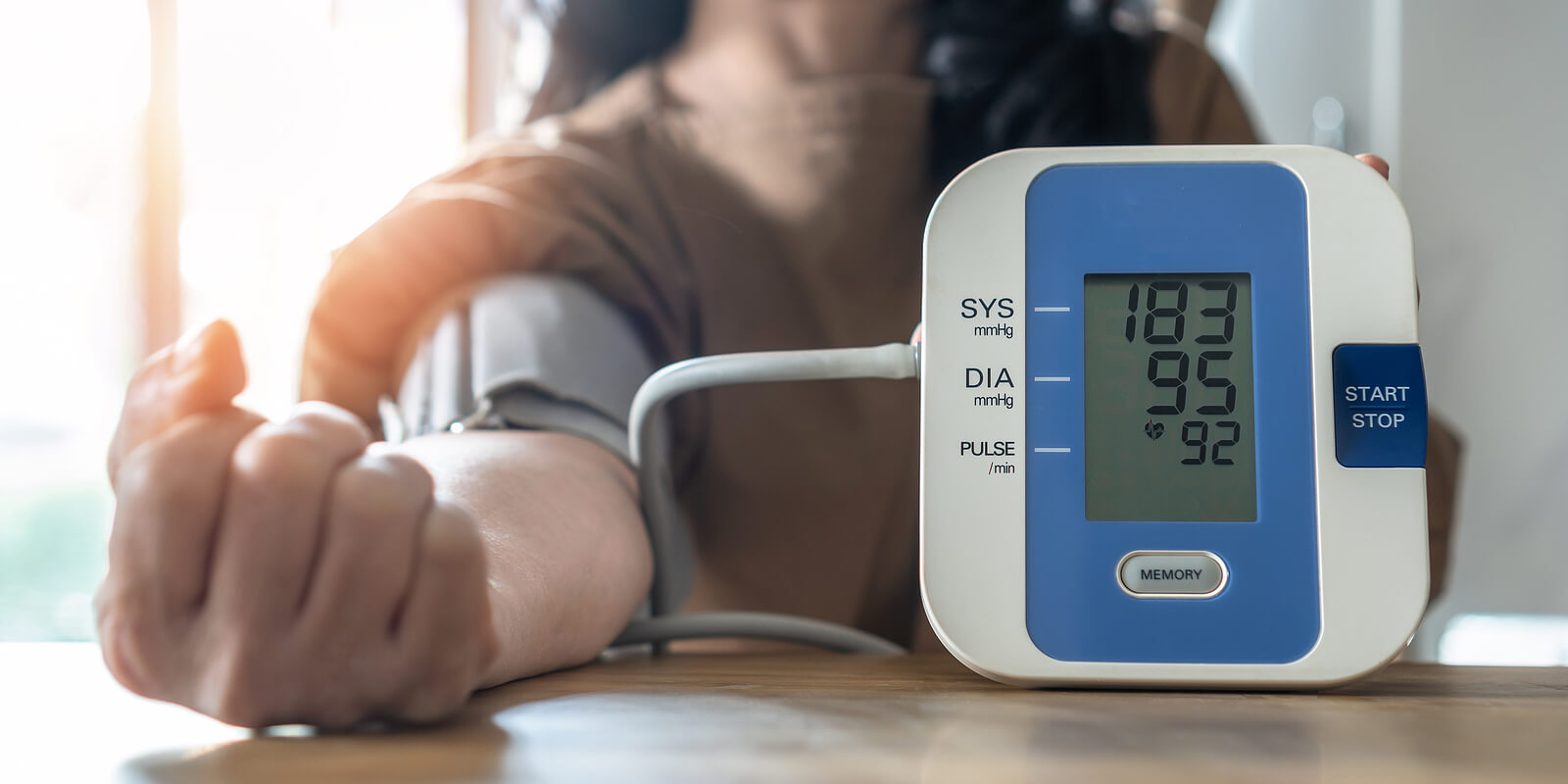How to Measure Blood Pressure at Home

Measuring blood pressure at home is possible thanks to electronic devices freely available on the market. Specialists usually recommend doing this if there’s a suspicion of hypertension, to corroborate the effectiveness of a treatment, or to reduce the sequelae associated with the disease (strokes, heart conditions, kidney diseases, and others).
Although its effectiveness is documented, people need to be informed about how to make a correct measurement in order to achieve more objective results. Today we’ll show you how to do it, its advantages, what you should avoid, as well as answering your most frequent questions about the results.
What’s MDPA and what’s it used for?

Home blood pressure measurement is a method used by specialists so that patients themselves, based on their indications, can keep track of their blood pressure levels. In order to do this, they use a digital blood pressure monitor, which are the most common machines today.
In contrast to ambulatory blood pressure monitoring, home blood pressure measurement is performed manually. The patient, on their own or with someone else, takes the measurement from home and keeps a record of the results by hand. The European Society of Hypertension (ESH) has identified the following advantages of carrying out this type of control:
- It provides specialists and the patient with many different measurements of their blood pressure at different times, different days, and different times of the year.
- With its help, it’s possible to measure the blood pressure in the patient’s usual environment. That means you’ll avoid the dreaded white coat hypertension in a doctor’s surgery.
- This method helps to better predict target organ damage from hypertension. This is partly because the tracking of values is more frequent.
- It shares most of the characteristics of its ambulatory counterpoint (in this case, the device measures blood pressure automatically).
- It helps to improve the understanding of the disease in patients and promote its follow-up.
- And, finally, it can be applied in the long term and it isn’t a very expensive method.
What’s the correct way to measure blood pressure at home?
Although the digital blood pressure monitors that are available on the market have improved greatly in terms of the reliability of the readings, they’re still conditioned by potential human error. This is why errors can occur that lead to a wrong diagnosis.
The correct way to measure blood pressure at home, following the recommendations of the United States Centers for Disease Control and Prevention (CDC), is based on these indications:
- Food and drink: It isn’t advisable to eat or drink 30 minutes before taking your blood pressure at home. This can alter the test values, as sodium, sugar, caffeine, and other agents have a direct impact on blood pressure.
- Tobacco: In the same way, you should avoid the consumption of tobacco around 30 to 60 minutes before the measurement. Smoking increases blood pressure, as studies have shown. Therefore, the results won’t be objective.
- Previous activity: Blood pressure should only be measured when you have been sitting still for at least five minutes. You shouldn’t carry out the measurement while standing or if you have been walking or doing exercise. Wait for a while in a seated position before taking the measurement.
More indications
- Leg position and body in general: Your legs should be on the ground, without crossing them. Doing so can put pressure on the blood vessels and cause the pressure to increase. Keep your back straight, your gaze upright, and try to relax and breathe deeply.
- Arm position and support: Your arm should be at chest level on a support (a table, for example); it shouldn’t be stretched vertically, either above or below the height of the heart. It has been shown that these variations can alter the results by up to 10% in the value obtained.
- Cuff position: The blood pressure cuff should cover about 80% of the arm and sit snug against the bare skin. If you adjust it, the result will be flawed.
Experts also recommend emptying your bladder before measuring your blood pressure at home and not speaking during the process. Write down the first result, wait six seconds, repeat the test and then compare the values. If the variation is minimal, keep both readings. If there’s a large difference between the measurements, wait another 60 seconds, and repeat the measurement a third time.
Questions and answers about measuring blood pressure at home
As you can see, measuring blood pressure from home isn’t complicated. Of course, you must follow the instructions to the letter to influence the results as little as possible. To finish guiding you in the process, we’ll answer some common questions:
How do I interpret the data?

Regardless of the brand or model of the digital blood pressure monitor you have, it’ll give you the data in two numerical ranges. The first, the highest, corresponds to the systolic pressure. Whereas the second, the lowest, is the diastolic pressure. The World Health Organization (WHO) states that normal blood pressure ranges between 120/80 mmHg.
It’s likely that your results won’t be identical to these, although the closer they are, the healthier it is for the body. According to the American Heart Association (AHA), a person is said to have high blood pressure when the values are equal to or greater than 130/90 mmHg. In contrast, they have low blood pressure when the results are equal to or less than 90/60 mmHg.
How often should I do it?
The frequency is determined by the specialist and based on their hypotheses. It’s common to carry it out twice a day: first thing in the morning and in the late afternoon. It’s very important to do it at the same time, and, in this way, you can monitor the readings better.
The specialist will usually recommend that the tests be spread out over a week. If tolerance to a drug is being tested or stronger results are needed, they can be maintained for two weeks or more. In any case, check with your doctor about what time and for how long you should do the measurements.
Can I use any blood pressure monitor?
We mentioned about improvements in devices for measuring blood pressure at home. Despite this, the American Heart Association (AHA) doesn’t recommend wrist devices for testing. These can give wrong values, even when opting for the most modern ones.
Try to use a bracelet model, preferably one recommended for the size of your arm. In turn, try to ensure that the brand or model is endorsed by an organization for your region.
Those approved by the American Medical Association (AMS) can be found here. A list of digital blood pressure monitors endorsed by the European Society of Hypertension (ESH), the International Society of Hypertension (ISH) and the World Hypertension League (WHL) is accessible from the following link.
What do I do with the results?
Each measurement will give you the blood pressure values at that particular moment. These must be carefully recorded to share with your specialist. CDC makes the following registry template available so that people can dynamically organize the results. You can use this one or create your own.
Whatever the case, the most important thing is that you keep track of them and to share them with the specialist, who is the one responsible for making the diagnosis of high blood pressure.
This can be done in person in the health center or hospital or online. Studies recommend the latter so that the patient doesn’t have to travel, and to be able to make modifications to the test from a distance (frequency, schedule, and changes in antihypertensive drugs ).
This evidence supports the use of home blood pressure monitoring. It’s a safe, easy, and permanent tool which can keep possible imbalances under control.
As it’s more effective to do it with an expert, try to share the results any questions with a medical professional. Ensure that you do this, especially if your results are above or below the recommended standard.
Measuring blood pressure at home is possible thanks to electronic devices freely available on the market. Specialists usually recommend doing this if there’s a suspicion of hypertension, to corroborate the effectiveness of a treatment, or to reduce the sequelae associated with the disease (strokes, heart conditions, kidney diseases, and others).
Although its effectiveness is documented, people need to be informed about how to make a correct measurement in order to achieve more objective results. Today we’ll show you how to do it, its advantages, what you should avoid, as well as answering your most frequent questions about the results.
What’s MDPA and what’s it used for?

Home blood pressure measurement is a method used by specialists so that patients themselves, based on their indications, can keep track of their blood pressure levels. In order to do this, they use a digital blood pressure monitor, which are the most common machines today.
In contrast to ambulatory blood pressure monitoring, home blood pressure measurement is performed manually. The patient, on their own or with someone else, takes the measurement from home and keeps a record of the results by hand. The European Society of Hypertension (ESH) has identified the following advantages of carrying out this type of control:
- It provides specialists and the patient with many different measurements of their blood pressure at different times, different days, and different times of the year.
- With its help, it’s possible to measure the blood pressure in the patient’s usual environment. That means you’ll avoid the dreaded white coat hypertension in a doctor’s surgery.
- This method helps to better predict target organ damage from hypertension. This is partly because the tracking of values is more frequent.
- It shares most of the characteristics of its ambulatory counterpoint (in this case, the device measures blood pressure automatically).
- It helps to improve the understanding of the disease in patients and promote its follow-up.
- And, finally, it can be applied in the long term and it isn’t a very expensive method.
What’s the correct way to measure blood pressure at home?
Although the digital blood pressure monitors that are available on the market have improved greatly in terms of the reliability of the readings, they’re still conditioned by potential human error. This is why errors can occur that lead to a wrong diagnosis.
The correct way to measure blood pressure at home, following the recommendations of the United States Centers for Disease Control and Prevention (CDC), is based on these indications:
- Food and drink: It isn’t advisable to eat or drink 30 minutes before taking your blood pressure at home. This can alter the test values, as sodium, sugar, caffeine, and other agents have a direct impact on blood pressure.
- Tobacco: In the same way, you should avoid the consumption of tobacco around 30 to 60 minutes before the measurement. Smoking increases blood pressure, as studies have shown. Therefore, the results won’t be objective.
- Previous activity: Blood pressure should only be measured when you have been sitting still for at least five minutes. You shouldn’t carry out the measurement while standing or if you have been walking or doing exercise. Wait for a while in a seated position before taking the measurement.
More indications
- Leg position and body in general: Your legs should be on the ground, without crossing them. Doing so can put pressure on the blood vessels and cause the pressure to increase. Keep your back straight, your gaze upright, and try to relax and breathe deeply.
- Arm position and support: Your arm should be at chest level on a support (a table, for example); it shouldn’t be stretched vertically, either above or below the height of the heart. It has been shown that these variations can alter the results by up to 10% in the value obtained.
- Cuff position: The blood pressure cuff should cover about 80% of the arm and sit snug against the bare skin. If you adjust it, the result will be flawed.
Experts also recommend emptying your bladder before measuring your blood pressure at home and not speaking during the process. Write down the first result, wait six seconds, repeat the test and then compare the values. If the variation is minimal, keep both readings. If there’s a large difference between the measurements, wait another 60 seconds, and repeat the measurement a third time.
Questions and answers about measuring blood pressure at home
As you can see, measuring blood pressure from home isn’t complicated. Of course, you must follow the instructions to the letter to influence the results as little as possible. To finish guiding you in the process, we’ll answer some common questions:
How do I interpret the data?

Regardless of the brand or model of the digital blood pressure monitor you have, it’ll give you the data in two numerical ranges. The first, the highest, corresponds to the systolic pressure. Whereas the second, the lowest, is the diastolic pressure. The World Health Organization (WHO) states that normal blood pressure ranges between 120/80 mmHg.
It’s likely that your results won’t be identical to these, although the closer they are, the healthier it is for the body. According to the American Heart Association (AHA), a person is said to have high blood pressure when the values are equal to or greater than 130/90 mmHg. In contrast, they have low blood pressure when the results are equal to or less than 90/60 mmHg.
How often should I do it?
The frequency is determined by the specialist and based on their hypotheses. It’s common to carry it out twice a day: first thing in the morning and in the late afternoon. It’s very important to do it at the same time, and, in this way, you can monitor the readings better.
The specialist will usually recommend that the tests be spread out over a week. If tolerance to a drug is being tested or stronger results are needed, they can be maintained for two weeks or more. In any case, check with your doctor about what time and for how long you should do the measurements.
Can I use any blood pressure monitor?
We mentioned about improvements in devices for measuring blood pressure at home. Despite this, the American Heart Association (AHA) doesn’t recommend wrist devices for testing. These can give wrong values, even when opting for the most modern ones.
Try to use a bracelet model, preferably one recommended for the size of your arm. In turn, try to ensure that the brand or model is endorsed by an organization for your region.
Those approved by the American Medical Association (AMS) can be found here. A list of digital blood pressure monitors endorsed by the European Society of Hypertension (ESH), the International Society of Hypertension (ISH) and the World Hypertension League (WHL) is accessible from the following link.
What do I do with the results?
Each measurement will give you the blood pressure values at that particular moment. These must be carefully recorded to share with your specialist. CDC makes the following registry template available so that people can dynamically organize the results. You can use this one or create your own.
Whatever the case, the most important thing is that you keep track of them and to share them with the specialist, who is the one responsible for making the diagnosis of high blood pressure.
This can be done in person in the health center or hospital or online. Studies recommend the latter so that the patient doesn’t have to travel, and to be able to make modifications to the test from a distance (frequency, schedule, and changes in antihypertensive drugs ).
This evidence supports the use of home blood pressure monitoring. It’s a safe, easy, and permanent tool which can keep possible imbalances under control.
As it’s more effective to do it with an expert, try to share the results any questions with a medical professional. Ensure that you do this, especially if your results are above or below the recommended standard.
- Alenta, H. P., García, P. A., & del Rey, R. H. Tabaco, presión arterial y riesgo cardiovascular. Hipertensión y Riesgo Vascular. 2003; 20(5): 226-233.
- Cappuccio, F. P., Kerry, S. M., Forbes, L., & Donald, A. (2004). Blood pressure control by home monitoring: meta-analysis of randomised trials. Bmj. 2004; 329(7458): 145.
- George, J., & MacDonald, T. Home blood pressure monitoring. European Cardiology Review. 2015; 10(2): 95.
- Parati, G., Stergiou, G. S., Asmar, R., Bilo, G., De Leeuw, P., Imai, Y., … & Mancia, G. E. S. H. European Society of Hypertension practice guidelines for home blood pressure monitoring. Journal of human hypertension. 2010; 24(12): 779-785.
- Yarows, S. A., Julius, S., & Pickering, T. G. Home blood pressure monitoring. Archives of Internal Medicine. 2000; 160(9): 1251-1257.
Este texto se ofrece únicamente con propósitos informativos y no reemplaza la consulta con un profesional. Ante dudas, consulta a tu especialista.







